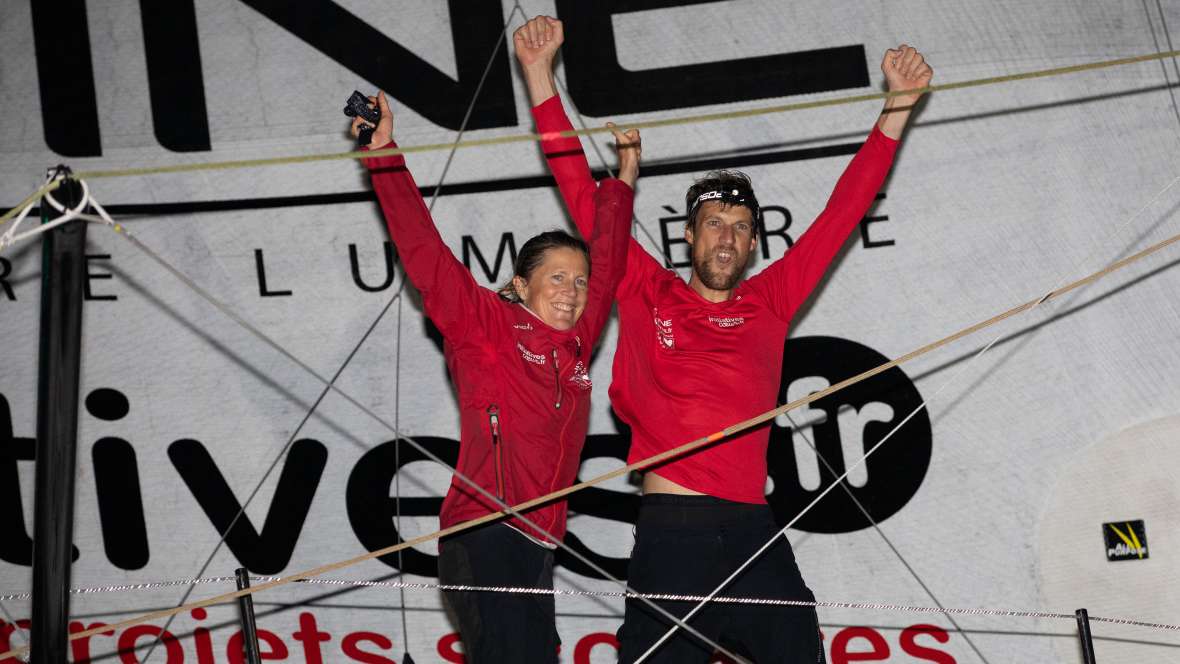The latest race news from the race

© Jean-Marie Liot/Alea
Initiatives-Cœur finishes seventh in the Transat Jacques Vabre Normandie Le Havre IMOCA
Britain’s Samantha Davies and French co-skipper, Paul Meilhat, on their 60ft monohull, Initiatives-Cœur, have finished seventh in the IMOCA class of the 14th edition of the Transat Jacques Vabre Normandie Le Havre after crossing the finish line in the Bay of All Saints in Salvador de Bahia, Brazil on Sunday, November 10, 2019 at 21:45:44 (UTC), 14 days, 9 hours 30 minutes and 44 seconds after leaving Le Havre, Normandy, France on Sunday, October 27 at 12:15 (UTC).
Initiatives-Cœur covered the theoretical course of 4,350 nautical miles at an average speed of 12.59 knots but actually sailed 4,962.94 nautical miles at an average speed of 14.36 knots. It finished 21 hours 22 minutes and 44 seconds behind the winner, Apivia.
This has been a Super Sunday measure in minutes and after a long chase down the north-east coast of Brazil, Initiatives-Cœur ran out of race track and could not quite reel in Banque Populaire, who were just 44 minutes and 20 seconds ahead of them.
"The difference in this edition is that now it is a real competition," Davies said after boat was moored on the pontoon in Salvador de Bahia, "For the first time there were 29 boats and it’s more like sailing at the level of the Figaro in terms of competition. To have a real regatta, all the way across the Atlantic in these machines is amazing. That’s the massive difference and hopefully it continues."
Leaving Le Havre, Britain’s Samantha Davies was as happy as for any of her previous five campaigns in this race – even if the childcare situation is always a bit stretched before departure because once again, her husband, Romain Attanasio was also skippering a boat, Pure. She was definitely more confident. Her boat, Initiatives-Cœur,was not the newest, but the 2010 VPLP design had huge and much admired new foils. She also had six months of training behind her with her co-skipper, Paul Meilhat, who finished second on older boat in the last edition. They were outsiders, but not dangerous ones.
Feeling at that newer boats might not be 100% ready they said to themselves they had to attack early – Davies said later that Meilhat helped her push harder in this regard. They lead for the first 24 hours, and were the first without hesitation to take the road south that nearly all other followed. A great start, perhaps a little too great because on the first night, the big gennaker – the A3 – could not take the muscular pace. They repaired it and put it away as the race turned into an upwind battle. They were always well placed in the top 5.
After the high-pressure ridge by Gibraltar, they re-hoisted the repaired sail, but it lasted only a few hours and Davies believes it cost them a couple of places – the positions bear that out. Losing a foil might have been less costly. She blamed herself for not managing her wardbrobe better.
From the Canaries, Initiatives-Cœurwas a little off the pace of the top five, forced to look for compromises of sails and different angles, all the time losing ground. The gap stabilized when the fleet entered the trade winds where the spinnaker replaces the flat sails – although a crash gybe showed how hard they were pushing. At the entrance to the Doldrums, they were still sixth. But stalled by squalls in the middle of their crossing more than their direct competitors, they dropped as far as thirteenth place on November 6. But once the trade wind returned, their foiler found wings as they reached along the coast of northeast Brazil and they managed to find a ranking worthy of their entire race.
Seventh in Salvador de Bahia, this is clearly not the place that they came for, but it illustrates the sharpness of the competition in the IMOCA now and the technical requirements at the highest level.


